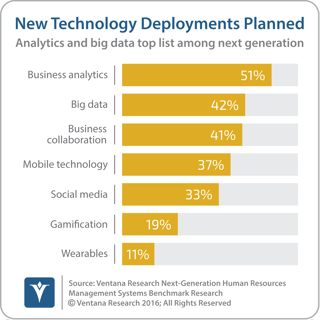Predictive HCM: The Benefits Are Real, as Are the Cautions
Two of the most impactful contributions of any HR department are driving employee engagement and employee productivity, outcomes that are highly correlated of course. These contributions are meaningful because, for an organization of any appreciable size, even fairly small upticks in employee productivity translate into significant financial benefit. The math is simple: Increase revenue per employee (for example, via technologies that enhance productivity) from $150,000 to $157,500 (just 5 percent) in a workforce of 5,000 employees and you capture $37.5 million in incremental revenue. The magnitude of this business impact is several times larger than shaving even 50 percent off the HR operating budget in an equivalent-sized organization.
But that’s a hypothetical. In the real world of your organization, where is that employee productivity improvement coming from? Maybe you’re thinking the answer involves having better-quality data that can drive better workforce-related actions and decisions. As a reference point, our Human Capital Analytics benchmark research found that organizations spend most of their time in analytics in preparing data for analytics and reviewing data for quality and consistency in almost half (46%) of organizations and a lot less time analyzing the data. Clearly, timely, accurate and consistent data is a factor in improving productivity, but the business value of accurately knowing employee engagement or productivity levels for the preceding quarter pales in comparison to the value of knowing what will likely happen in the next quarter. And it is even more valuable to know why employee engagement levels will probably change in the next quarter. This is where analytics come in to help HR organizations craft and lead more effective HCM actions and programs. Our Next Generation Human Resources Management Systems benchmark  research found that business analytics is the top technology planned for deployment in 51 percent of organizations followed by big data (42%) which is intended to provide a centralized and managed environment for analytics.
research found that business analytics is the top technology planned for deployment in 51 percent of organizations followed by big data (42%) which is intended to provide a centralized and managed environment for analytics.
For HR leaders, being able to predict what changes will likely occur in the workforce and why would be significant progress toward supporting better top-line business performance. But things really start to get exciting when, with new tools and predictive frameworks, HR teams can also help organizations avoid adverse circumstances like a downturn in engagement or an increase in employee turnover or HR-related compliance problems.
This is the essence of predictive HCM, an emerging approach that enables HR to know what will likely happen in the workforce and why, and managers to avoid disruptive, resource-draining HCM problems.
As HCM systems keep evolving and HR functions become more comfortable operating in the data science arena, opportunities to use predictive HCM across the employee life cycle will abound. As a result, the overall employee experience will improve. Early capabilities include predicting flight risk, job fit/job match and performance; down the road we will see innovations in predicting gender-biased decision-making, various types of compliance and safety risks, and even when “passive” (talented but not looking) job candidates will be more receptive to other opportunities.
What else is coming down the pike? When will HCM systems deliver the ability to predict the best learning approaches for each employee or who has clear leadership potential – or conversely, who might exhibit poor judgment or low personal integrity, or which highly valued candidates will opt out of the recruitment process and when?
As with all powerful technologies, however, predictive HCM carries potential risks of misuse. With all predictive tools, organizations should avoid acting before establishing algorithmic validity and the non-bias of those constructing or interpreting the frameworks. Our Next Generation Predictive Analytics benchmark research found that 42 percent of HR organizations are planning to use predictive analytics and almost as many are evaluating them for use in their organization. For those that have adopted predictive analytics for HCM, over a third (34%) have found increased workforce productivity as a top benefit. Are you prepared to use them and gain value from them?
The trajectory of predictive HCM, what might lie ahead, and how to evaluate the readiness of your organization and the technology required will be covered in my live 30-minute webinar on Jan. 16th at 2pm ET/11am PT. You can register now.
Authors:
Ventana Research
Ventana Research, now part of Information Services Group (ISG), is the most authoritative and respected market research and advisory services firm focused on improving business outcomes through optimal use of people, processes, information and technology. Since our beginning, our goal has been to provide insight and expert guidance on mainstream and disruptive technologies. In short, we want to help you become smarter and find the most relevant technology to accelerate your organization's goals.









